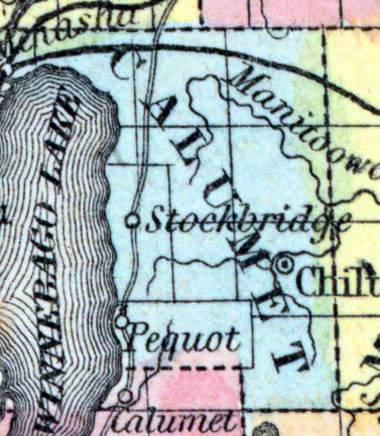CALUMET COUNTY, situated in the easterly part of Wisconsin, on the east side of Lake Winnebago. Area, 300 square miles. Seat of justice, Pequot. Pop. in 1840, 275; in 1850, 1,743. (Fanning's, 1853)
CALUMET, a county situated in the E. part of Wisconsin, contains about 800 square miles. Winnebago lake bounds it on the W, and it is drained by the branches of Manitowoc river. The surface is traversed by a high ridge nearly parallel with the lake. The land is fertile, and produces abundance of timber, wheat, corn, oats, barley, potatoes, hay, and butter. In 1850 this county yielded 7827 bushels of wheat; 8428 of oats; 10,632 of corn; 8887 of barley; 9116 of potatoes; 846 tons of hay, and 21,688 pounds of butter. It contained 1 church, and 173 pupils attending public schools. The rocks which underlie the county are blue limestone and sandstone. Calumet county was organized, for judicial purposes, in 1850. Capital, Chilton Centre. Population, 1743. (Baldwin's New and Complete Gazetteer of the United States..., 1854)
CALUMET, County, is bounded on the north by Brown and Outagamie, on the east by Manitowoc, on the south by Sheboygan and Fond du Lac, and on the west by Winnebago. It was set off from Brown, December 7, 1836, and organized for county purposes, January 6, 1840. On the 13th of August, 1840, it was disorganized, and its territory attached to Brown. It was again reorganized February 18, 1843, remaining in judicial connection with Brown until the organization of Fond du Lac, January 22, 1844, to which it was attached for judicial purposes. It was fully organized February 5, 1840. The seat of justice is at Chilton Centre, in the town of Charlestown, being in town 18 N., of range 20 E. It is well watered by tributaries of the Manitowoc river, and by small streams entering Lake Winnebago. The Brothertown and Stockbridge Indians have fine settlements, schools, and churches, in this county, and their farms and buildings compare favorably with others in the State. They are entitled to all the privileges of citizenship, and are frequently represented by some of their own number in the State legislature. This county contains much good land, which is for sale at low rates; the soil is good, and covered with a heavy growth of hard timber. It forms a portion of the fourth judicial circuit, of the third congressional, and of the first senate district, and sends one member to the assembly. The population in 1840 was 275; 1842, 407; 1846, 836; 1847, 1,060; 1850,1,746. Farms, 243; manufactories, 5; dwellings, 381. The county officers for 1853 and 1854 are: County Judge, Moody Mann; Sheriff, J. S. Hammer; Clerk of Court, Charles Growing; Register, L. P. Fowler. (John Warren Hunt, Wisconsin Gazetteer..., Madison, 1853)

